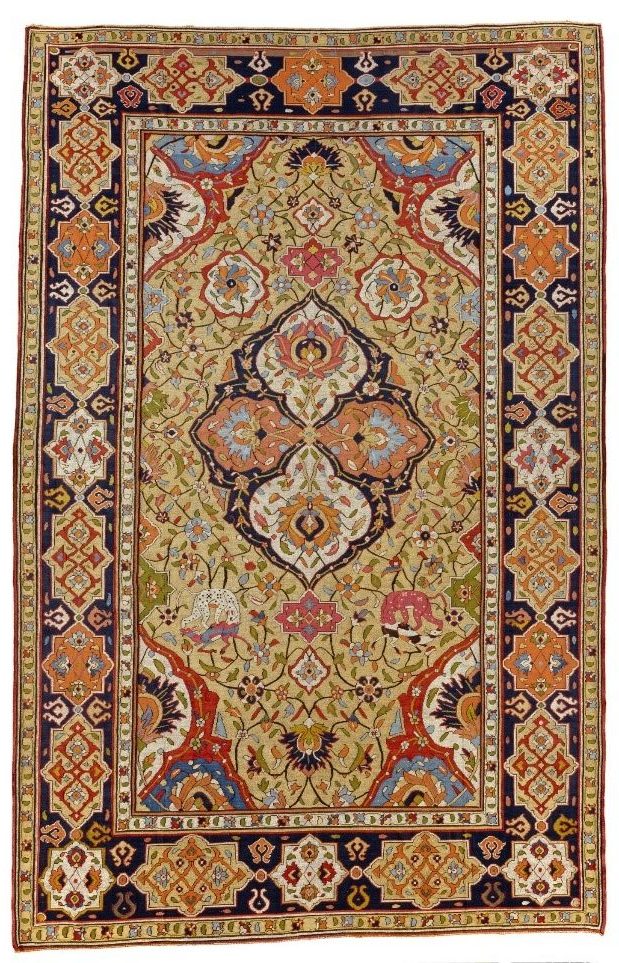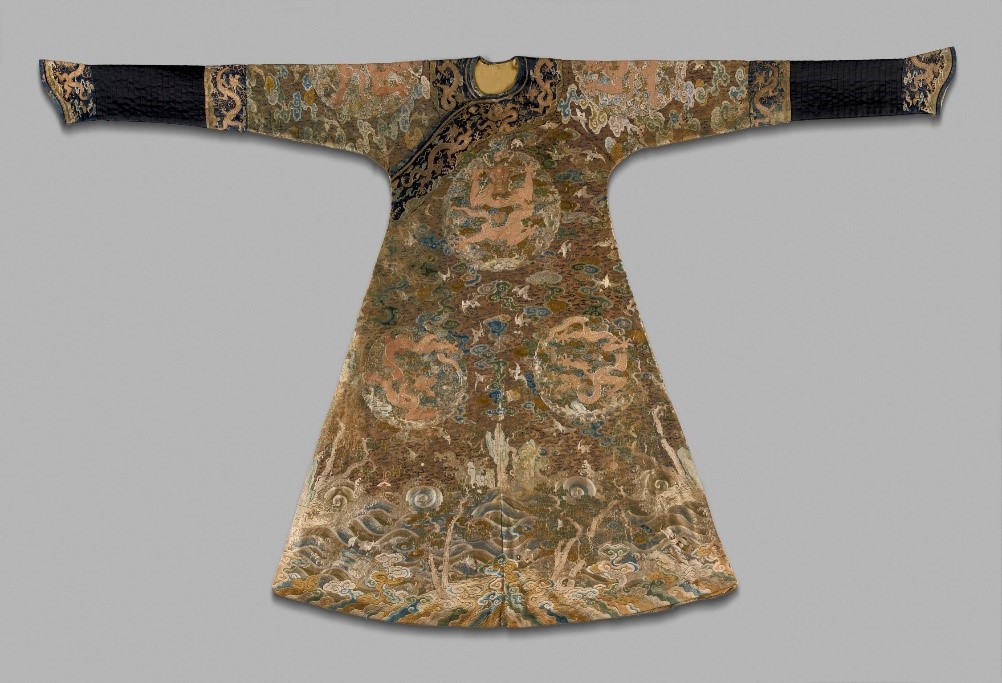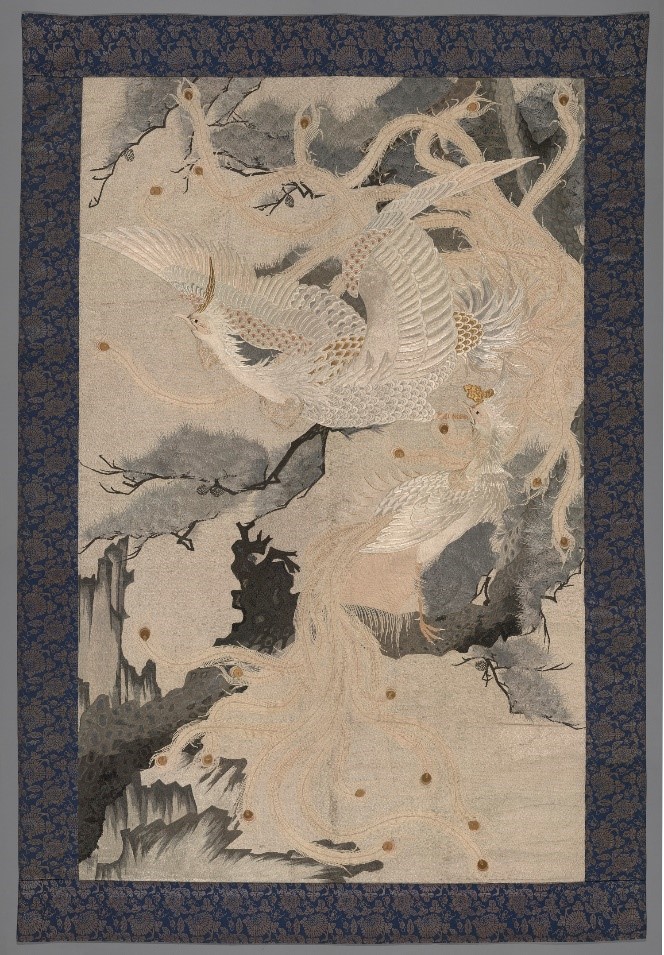Rarely Seen Asian Textiles On View at Nelson-Atkins
Objects Range from the Breathtakingly Grand to the Intimately Personal
Kansas City, MO, Kansas City, MO, Sept. 8, 2021– For the first time in decades, The Nelson-Atkins Museum of Art in Kansas City will display precious, rarely seen Chinese, Indian, Japanese, Persian, and Turkish costumes and textiles. Weaving Splendor: Treasures of Asian Textiles opens Sept. 25 and runs through March 6, 2022. Made with fine materials, exemplary techniques, and artistry, Asian luxury textiles were treasured locally and were central to global trade. The sumptuous textiles in this exhibition conveyed the identities, status, and taste of both local and international patrons and consumers.
“With their distinctive styles and deft craftsmanship, the garments, carpets, and wall hangings in this exhibition showcase the varied art and cultures across Japan, China, India, Iran, and Turkey,” said Julián Zugazagoitia, Menefee D. and Mary Louise Blackwell CEO & Director of the Nelson-Atkins. “These magnificent objects demonstrate Asia’s pivotal role in the making of luxury textiles and their circulation in the global cultural economy.”

Weaving Splendor is curated by Ling-en Lu, Curator of Chinese Art, Kimberly Masteller, Jean McCray Beals Curator of South and Southeast Asian Art, Yayoi Shinoda, Assistant Curator of Japanese Art, and Michele Valentine, Department Assistant, South and Southeast Asian Art. Costumes of the court communicated power, while theater robes brought stage characters to life. Ornate wall hangings and furniture covers transformed palaces, temples, and homes, while shimmering, tapestry-woven carpets were created as diplomatic gifts for foreign rulers. The stories of these treasures of the collection take visitors on a remarkable journey across continents from the 1500s to today.
“These fine textiles are treasures that are rarely seen,” said Masteller. “Because of their light sensitivity and fragility, textiles spend much of their lives in museums in the dark, protected and preserved for generations to come. This exhibition offers a chance to see these Asian art treasures together on view, and is a once in a lifetime opportunity.”

More than two dozen extraordinary works spanning the entire continent are included in Weaving Splendor, demonstrating Asia’s centrality to the global cultural economy, historically and today.
“For centuries, Chinese textile artists produced the most refined silk textiles utilizing luxury materials and techniques to make the garments not only functional but also appreciated as artwork,” said Lu. “One example is the picturesque embroidery of the One Hundred Cranes Robe, which came from the Qing dynasty imperial tomb of Prince Guo (1697–1738). This rare garment is widely considered to be one of the most important Chinese textiles in the United States.”

Prince Guo was buried with this robe and many other textiles for his afterlife. Artists enhanced the formal style of the dragon robe with dense, complex embroidery. They achieved the detail of a painting, covering the silk damask fabric with dragons, pine trees, waves, cranes, and peaches. These images that carried positive meanings would have blessed the Prince.
The exhibition will share in-depth histories on a number of works. The Tapestry Woven Medallion Carpet, created in Iran around 1600, has an illustrious and international history, both through its materials, which include dyes sourced in the New World, and through its provenance, as a gift from the ruler Shah ‘Abbas I to the Pope in Rome, and then to a cardinal and his family before its sale to the Nelson-Atkins in 1932. Its color is nearly as vibrant today as the day it was woven.
Between the late 1800s and early 1900s, Japanese artists made many high-quality textiles for American and European customers. These textiles were sold at international expositions, department stores, and art galleries in Europe, Japan, and the United States. They were also presented as diplomatic gifts from the imperial house and government to political allies. Japanese textile makers faced many challenges in the late 19th century, but nimbly adopted to the new economic and social changes. They did not reset their knowledge and skills, but built upon what they learned from predecessors in previous centuries by studying and adopting new clients’ taste and needs and new weaving technology brought from Europe.
The exhibition will also spotlight local fascination with Asian textiles. In the late 1800s, affluent Americans like Kansas City’s Jacob and Ella Loose boarded steamships and set sail for Asia. There they explored firsthand cultures and lands largely understood in the United States through published accounts, and as most tourists do, they shopped. Luxurious tapestries and wall hangings, like those produced in Japan and later donated by the Looses, were easy to pack for safe travel home. European and American collectors like the Looses purchased these large and impressive textiles to decorate their mansions.
As visitors leave Weaving Splendor, they will encounter the Creativity Studio, a hands-on gallery to experiment with textile processes. Making stations will be available where visitors will be able to design a garment, weave on a loom, embroider, and watch videos that offer glimpses into the creative practices of artists continuing the traditions of the textile makers in Weaving Splendor.
Weaving Splendor is the fourth exhibition to open in a vibrant line-up at the Nelson-Atkins showcasing the power of human creativity. Testimony: African American Artists Collective runs to March 27; Castles, Cottages, and Crime runs to March 6, as does Origins: Collecting to Create the Nelson-Atkins. Castles, Origins, and Weaving Splendor are all ticketed exhibitions, and can all be seen for the price of one ticket.
Public Programs for Weaving Splendor:
Saturday, Nov. 6, 2021, 1 p.m.
Special Presentation
Why are Textiles Masterpieces?: Asian Textiles in Weaving Splendor
Join historian and author, John Vollmer, as he discusses textile displays from the exhibition, imparting insights about silk and its impact on global trade and fashion.
Zoom Webinar
Presented with live captioning.
Saturday Feb. 19, 2022, 9 a.m.
Special International Panel Discussion
Contemporary Asian Textiles: In Conversation with Designers and an Artist
Enjoy an international panel discussion featuring Angel Chang, Asian American designer of seed-to-button, zero carbon womenswear that is handmade by ethnic minority women artisans in Guizhou, China, Matsubara Nobuo, Japanese artist specializing in indigo and stencil-dyed textiles, and Hema Shroff Patel, Mumbai textile practitioner with a central Indian revival textile workshop, Amba; as they share their connections to Asian textile traditions. The conversation is moderated by William Keyse Rudolph, PhD, Deputy Director, Curatorial Affairs at The Nelson-Atkins Museum of Art.
Zoom Webinar
Presented with live captioning
Saturday, Jan. 22, 2022, 11 a.m.
Take 5
Fibers
Lens 2
An eclectic and lively conversation centered on the multiplicities of textiles. Pauline Verbeek-Cowart, Professor and Chair/ Fiber Department, Kansas City Art Institute; Joy Ruan, antique, Chinese garment and accessories collector; Rachel Freeman, Associate Conservator at the Nelson-Atkins and moderator Maria Vasquez Boyd, host of KKFI’s Artspeak Radio, share their personal connections to the world of fibers, from solace in their craft, to sustainability and living traditions.
Image captions: Tapestry-Woven Medallion Rug, early 17th century, Persian, Kashan, Iran, Safavid Dynasty (1501-1722). Silk and silver metallic wrapped thread, 7 feet 11 1/2 inches x 5 feet 1 1/2 inches (242.6 x 156.2 cm). The Nelson-Atkins Museum of Art, Kansas City, Missouri. Purchase: William Rockhill Nelson Trust, 32-70. Photo © 2007 The Nelson Gallery Foundation: Jamison Miller.
One Hundred Cranes Imperial Robe, Chinese, Late 17th-early 18th century Qing Dynasty (1644–1911). Embroidered damask, 57 7/8 x 91 inches. Purchase: William Rockhill Nelson Trust, 35-275. Photo © 2018 The Nelson Gallery Foundation: Gabe Hopkins.
Hanging, Japanese, Late 19th to early 20th century. Silk and gold embroidery, Overall: 83 3/8 x 57 ½ inches. Bequest of Ella C. Loose, 45-70/53. Photo © 2015 The Nelson Gallery Foundation: Matt Pearson.
The Nelson-Atkins Museum of Art
The Nelson-Atkins in Kansas City is recognized nationally and internationally as one of America’s finest art museums. The Nelson-Atkins serves the community by providing access to its renowned collection of more than 42,000 art objects and is best known for its Asian art, European and American paintings, photography, modern sculpture, and Native American and Egyptian galleries. Housing a major art research library and the Ford Learning Center, the museum is a key educational resource for the region. The Nelson-Atkins is located at 45th and Oak Streets, Kansas City, MO. Hours are 10 a.m.–5 p.m. Mondays, Thursdays, Saturdays, and Sundays, 10 a.m. to 9 p.m. Fridays, and closed Tuesdays and Wednesdays. Admission to the museum is free to everyone. For museum information, phone 816.751.1ART (1278) or visit nelson-atkins.org.
For media interested in receiving further information, please contact:
Kathleen Leighton, Manager, Media Relations and Video Production
The Nelson-Atkins Museum of Art
816.751.1321, kleighton@nelson-atkins.org